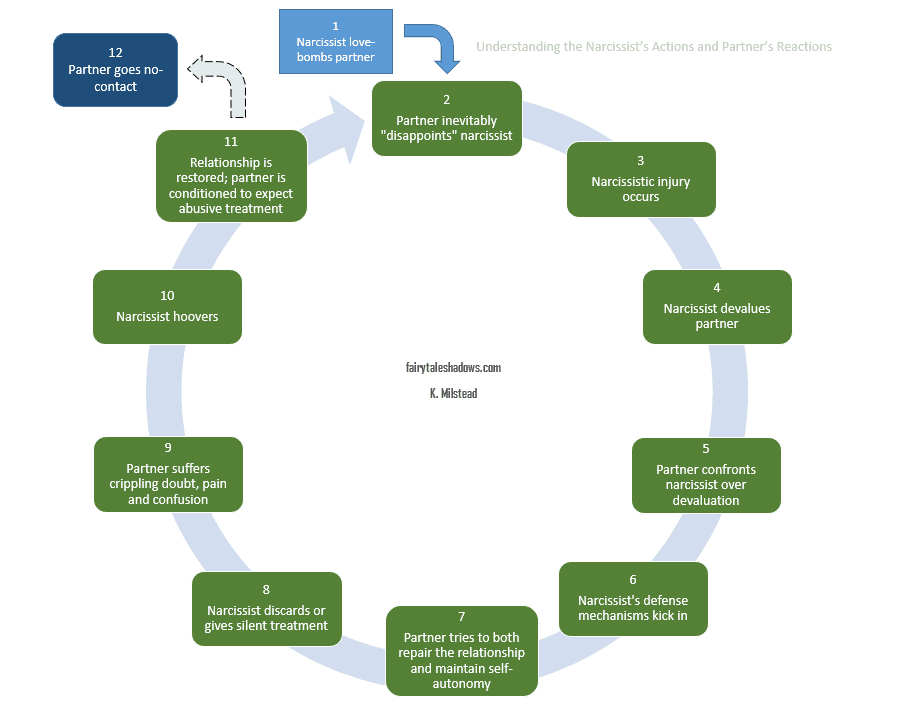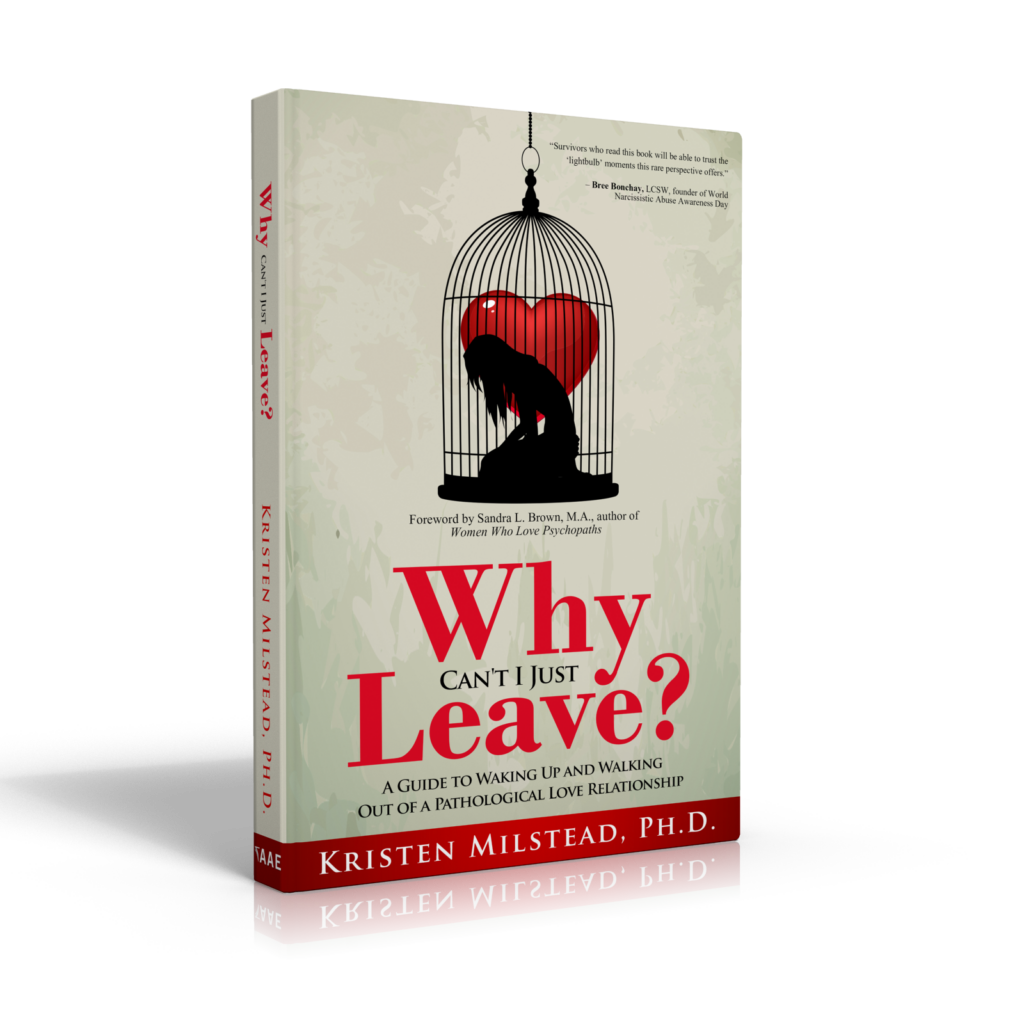When we are in relationships with narcissists, we are constantly trying to figure out how to change course. Anything other than go “no contact.”
For example, if we could just explain to them how their behavior is hurting us, then perhaps they would stop.
Things never align. We never reach the elusive dream of a loving relationship characterized by honesty and respect.
Instead, we find ourselves becoming weaker and more exhausted trying to do things that are beyond the bounds of what we should be expected to give.
It’s a merry-go-round we either ride until we’re sick or that we finally stumble off when we realize it will never stop on its own.
Understanding why these are the only two options is the secret to saving ourselves.
Why Going No Contact is So Hard
The idealize-devalue-discard model for explaining narcissistic abuse provides a basic structure for understanding the foundation of a pathological love relationship with a narcissist.
First, during the idealization stage, we are put on a pedestal and viewed as the love of the narcissist’s life.
Then, we are denigrated as worthless and subjected to some of the cruelest treatment we have ever endured.
Finally, we are thrown away, shunned, and ignored as if we never existed. The cycle repeats.
But why do these three stages occur? Why would anyone idealize then devalue that same person? What keeps the person who experiences this treatment from exiting the cycle immediately?
The idealize-devalue-discard cycle is a trap that evokes responses from us that we otherwise would not have in ordinary circumstances.
A deeper understanding of the relationship dynamics should be based on the narcissist’s disordered view and how it draws the partner into their dysfunctional lens. It can help to show:
- How the narcissist’s actions guide the relationship toward dysfunction, and
- Why the partner’s reactions do not lead to an outcome outside the painful cycle.
While in the relationship, it can feel impossible to break away and go no contact. By expanding the traditional cycle of narcissistic abuse, we can learn more about why:

The Expanded Narcissistic Cycle of Abuse
Stage 1. The Narcissist Love-Bombs the Partner
This is the first stage in the cycle in a relationship with a narcissist, previously noted as the idealization stage.
As the narcissist idealizes the partner, both experience an emotional high in the brain that is so powerful, it can simulate cocaine use as certain neurotransmitters are released.
The narcissist puts the partner on a pedestal and begins to mirror both the physical actions and personal likes and dislikes of the partner. The narcissist creates an emotional “safe space” of utter acceptance that induces positive feelings of love, trust, and vulnerability.
This “safe space” is a reflection of all that the partner wants to hear and see because it’s based upon what the narcissist has learned of the partner’s identity and background. There is fast “familiarity” and “future-orientation” in the relationship, accompanied by grandiose statements about destiny or a once-in-a-lifetime connection.
For narcissists, this period of idealization is what they crave most, as it is when they receive the purest form of their own idealized view of themselves reflected back to them from their new partners.
By crafting an image of themselves that reflects what the partner needs to see to be comfortable in the relationship, the narcissist receives a high quality of narcissistic supply in the form of adoration, attention, and love.
Stage 2. The Partner Inevitably “Disappoints” the Narcissist
The idealization stage may last weeks, months or even a year or longer, but it cannot be maintained because it is built on illusions about who the narcissist truly is. The narcissist has manufactured a false persona that doesn’t truly exist.
In addition, the relationship is not supported by the principles that must comprise a healthy relationship, such as mutual trust, honesty, and commitment.
Many different things can trigger in the narcissist that their partner is a “disappointment,” such as:
- The narcissist becomes bored with the relationship or partner as the problems of the real world start to penetrate the dream-like quality of the idealization stage.
When the real world pierces through the idealized one, the narcissist starts to feel life sliding into mediocrity.
For example, the partner may go to the narcissist with a problem he or she is having and the narcissist doesn’t want to deal with those. “Problems” interfere with the narcissist’s ability to receive the supply they need from their partner.
They can no longer keep the emptiness and the internalized sense of worthlessness at bay. Narcissists may become irritated that they have to focus on someone else or someone else’s problems.
- The narcissist has secret lives and it starts to cause a strain on the relationship.
Narcissists have a sense of entitlement about having two sets of rules about their extracurricular activities, such as lying and cheating, but this can result in two things.
First, the narcissist never truly trusts their partner because they projects all of their secret behavior onto the partner. As a result, the narcissist tries to control the partner.
Second, the partner’s intuition may tell them that something is off, and when the partner speaks up, the narcissist may begin to gaslight them. Either of these things may lead the narcissist to become irritated with the partner, despite the narcissist being the one to engage in the betrayals.
- The narcissist starts to see “flaws” in the partner.
These things that narcissists view as flaws can range from saying no to the narcissist’s request or choosing a night out with friends, asking questions about suspicious behavior, or merely holding a different opinion.
When the partner does not make the narcissist the center of attention, the narcissist feels offended.
- The narcissist begins to feel threatened by the partner’s autonomy.
Narcissists like to know what their partners are doing at all times. They can also be threatened by a partner’s independence or by a partner knowing more about a subject or having more of something than the narcissist does.
They don’t like to be “outshined,” even if they also look good by association, as it draws attention away from themselves. For a narcissist, too much independence may mean the partner will abandon or reject them.
While narcissists see these issues as problematic, to them the problems exist because the partner will not do or stop doing something that they have a basic human right to do. They lack the self-awareness and ability to recognize that the problems exist because of their perception of their partner’s behavior.
The narcissist then feels disrespected and unappreciated.
Stage 3. Narcissistic Injury Occurs
As the partner continues to assert autonomy and independence, the narcissist’s resentment grows.
When the partner does not do something the narcissist wants, no matter how outrageous a violation of human dignity it might be, it feels like a slap in the face to the narcissist:“Look at all this effort I put in to give her everything she wanted. This is the thanks I get. She doesn’t even know how lucky she is.”
The partner’s love and attention is no longer good enough. The narcissist demands that the real world stay suspended forever and the partner forever keep them at the center of their lives.
Without the partner’s undivided attention, the narcissist is reminded or his or her own fears and insecurities. They feel wounded by what they perceive as the partner not “playing along” and seek to take back what the things they gave when morphing into the “perfect partner.”
Narcissists feels entitled to do whatever they want to do, even if it hurts the partner. Feeling wronged, to soothe their ego, the narcissist may engage in behavior that violates the sanctity of the relationship to avoid feeling as if they’re in the one-down position.
Stage 4. The Narcissist Devalues the Partner
Narcissists suffer from something called “object constancy.” If you’re not with them, you’re against them. If you have caused them a narcissistic injury, they see your actions as intentional attempts to disrespect them. Once you are placed into the “bad” category, you are viewed as the enemy.
Partners who cannot be controlled or do not conform to expectations incite narcissistic rage and so the narcissist lash out at the partner in revenge.
The verbal abuse may be subtle at first. This is where we usually hear phrases such as:
“Nothing I do is ever good enough for you.”
“If you loved me, you’d do [x].”
“All you want to do is argue.”
“I don’t have to tell you anything.”
“You always have to bring up [x] and ruin everything.”
“You’d better call me back in five minutes or it’s over.”
The partner is shocked and baffled by the sudden change in the narcissist.
Where is the person they fell in love with? Why is the narcissist so angry?
Eventually, the abusive words take a darker turn and the narcissist might start to be cruel. They may denigrate and humiliate the partner more directly for the “disappointments.” Devaluating their partner feels justified because they lack the control they feel entitled to have.
Because they also have low empathy, there may be almost no limits to what narcissists are willing to do to hurt their partners. They will employ the “nuclear option” to destroy and discredit their partners.
Stage 5. The Partner Confronts the Narcissist Over Being Devalued
The partner’s shock and sadness may feel crushing, yet it will unleash a barrage of questions and self-doubt.
The partner will be blindsided by the cruel about-face. It will seem illogical, and the partner will not be able to figure out what caused such an extreme reaction.
The extreme devaluation by the narcissist is at complete odds with the soulmate persona that was portrayed by them at the beginning of the relationship.
Even more confusing, once the narcissist cools off, they may pretend as if the incident of devaluation never happened or was no big deal. Once the narcissist has gone off and diffused the injury to their ego by exacting revenge in some way, the damage is under control. The balance feels restored and “normality” has returned.
To the partner, however, nothing feels normal. Hurt and confused, they confront the narcissist to get an explanation that will make this behavior make sense.
Stage 6. The Narcissist’s Defense Mechanisms Kick In
During this stage, the narcissist engages in a variety of verbal tactics to deflect, project, gaslight, blame-shift, and even stonewall.
You’re too sensitive.
That’s not what I said. You heard me wrong.
Well, what about that time you said [something unrelated]?
I have been really stressed out. I’m sorry– it won’t happen again.
Can’t we leave this in the past? I told you I’d never do it again. If you can’t stop talking about it, I’m leaving.
This is all part of the word salad that narcissists use in circular conversations that minimize partner’s pain, avoid taking responsibility and keep their abuse and the real nature of the relationship hidden.
What narcissists cannot accept is that they are wrong or and even to hear that they have harmed their partners is to feel criticized by them.
It sparks feelings of weakness and shame to hear from them that they have done something that is less than perfect.
Stage 7. The Partner Tries to Hold the Relationship Together While Maintaining His or Her Self-Respect and Autonomy
The turn that the relationship has taken appears to defy logic to the partner.
The sweet and thoughtful person they fell in love with now attacks them for reasons the partner doesn’t understand. When asked about it, the narcissist denies the attacks were attacks or claims that allude to the idea that the attacks were deserved.
Partners may draw one of two possible conclusions:
- The person we are with is disordered, because it doesn’t make sense that someone can seem to switch love on and off like a light switch, OR
- There is a misunderstanding and the excuses that the narcissist provides are genuine. If we can just do the right things, all of the “bad times” will stop and things can be as they were in the beginning.
The two competing ideas cause a psychological conflict known as cognitive dissonance. It’s not possible to hold two contradictory thoughts in one’s head at the same time.
Resolving the contradiction in favor of our initial impression of the narcissist at this point is the most reasonable psychological response.
In other words, the narcissist presented themselves as kind, thoughtful, and generous in the beginning of the relationship. It doesn’t make sense to believe that they actually don’t care about their partners or intend to hurt them.
When narcissists provide explanations for their behavior, even though the explanations may be outrageous, the fact that they had a “reason” aligns with this first impression of them as loving and kind.
It make sense psychologically for partners to believe that there has been a mistake and to reject the idea that the narcissist is actually cruel and callous.
This is the stage where partners are unknowingly drawn into the narcissist’s distorted reality. By accepting the narcissist’s view on the incidents, partners begin to lose touch with their own intuition and judgment.
Stages #2-7 form a mini-cycle within this larger cycle. The more times this mini-cycle repeats, the less partners in these relationships trust themselves as they become further entrenched in the narcissist’s version of their relationship.
Stage 8. The Narcissist Gives a Silent Treatment or Discards the Partner
After many iterations of the mini-cycle, the partner usually becomes very traumatized by the emotional and psychological abuse perpetrated by the narcissist.
Being drawn into the narcissist’s reality provides an extremely volatile and unhealthy world for the partner and their “fight or flight” instincts may now be triggered.
Some of the ways it may manifest itself include withdrawing emotionally out of fear of having to walk on eggshells; overwhelming anxiety over the consistent feeling that something is off and attempting to alleviate it by asking the narcissist what’s happening; feeling so hurt and broken-hearted over what has happened, that depression sets in; or reacting or trying to stand up for oneself when provoked by further devaluation (fight).
After the mini-cycle repeats over time, the narcissist also changes. They become completely disillusioned with the partner as the partner continues to “disappoint” the narcissist with normal human behavior.
The narcissist is disgusted with the partner’s behavior. To the narcissist, the partner is either combative, abusive and jealous, crazy and never satisfied, or is self-absorbed and inattentive.
Recognizing that the partner is no longer providing unquestioning worship and devotion, the narcissist rejects the partner.
To avoid the feelings of worthlessness that come from their partner’s trauma, the narcissist will give a silent treatment or even discard the partner and disappear at this stage for days or weeks at a time– or even longer.
Stage 9. The Partner Suffers Crippling Pain, Doubt, and Confusion
The entire relationship to this point has been held in place by the dominance and control of the narcissist through hundreds or thousands of instances of emotional and psychological (and sometimes physical or sexual) abuse.
The emotional and psychological abuse tactics are important because they were the invisible bullets that eroded the partner’s sense of self. The partner has at least partially adopted the narcissist’s points of view, which may include:
- “I’m too sensitive.”
- “I caused this to happen.”
- “I’m exaggerating or just plain wrong about what’s happening here.”
- “The narcissist love me and doesn’t want to hurt me but if I just try a little harder, they will stop.”
In contrast, the harmful reality that has been downplayed, ignored, and hidden through the narcissist’s emotional and psychological abuse are:
- the narcissist’s view of the partner fluctuates between extremes (which is not normal) and the fluctuation itself does not represent love but control
- the narcissist equivocates their abuse with the partner’s autonomy and their reasonable, human behavior
- the partner endures and reacts to the narcissist from a position of extreme volatility and abuse
- the narcissist tries to suppress and deny the partner’s lived experience of the relationship as painful and confusing
During silent treatments, the partner suffers tremendously because their reality has been warped through the manipulation of events– the narcissist putting on a show of being a loving person with surface-level actions and promises but without the commitment and support underlying such a relationship.
Further, the narcissist does not take responsibility for the harmful behaviors that undermine the soulmate facade that he or she has conveyed.
The partner will likely feel panicked that the narcissist is gone, after having taken on the view of the narcissist, which has instilled doubt in his or her own intuition and judgment.
He or she will likely miss the narcissist and wish for another chance to try to “get things right” so that everything will only go back to the way it once was, the way it was during Stage #1.
The partner may be hurt by what the narcissist has done and may believe there is still some way to reconcile the narcissist’s hurtful actions with the dream that the narcissist has fed him or her if only he or she would stop talking about them– as if talking about them is the problem, and not the fact that the narcissist acted hurtfully.
Stage 10. The Narcissist Hoovers
The partner is extremely vulnerable to being drawn back into the relationship. Even if the partner doesn’t reach out to the narcissist, the narcissist will likely reach out to the partner using hoovering attempts. [Read Signs the Narcissist You Know is Hoovering You]
The narcissist hoovers once he or she feels that the partner is conciliatory enough to accept that it is the narcissist who is the true victim. When this thought has settled in, the narcissist will not have to work very hard to gain back control over the partner.
The partner will “forgive” the narcissist and stop asking questions or look the other way.
The partner will apologize for being too “needy” or “jealous” or for lashing out in response to being repeatedly devalued or baited. The narcissist’s context of abusive control is conveniently ignored.
The narcissist may apologize too and promise change in an attempt to hoover if necessary, but the acknowledgment of the wrongs done will lack insight.
Any explanations and excuses will be shallow and unsatisfying. The narcissist will not be able to offer explanations for what they have done that make sense.
On the surface, things may be good again for the moment, but underneath, the foundation is still rotten. All the partner wants is for the confusion and pain to stop, and so it does– for a price.
Stage 11. The Relationship is Restored But the Partner is Conditioned to Expect Abusive Treatment
The narcissist has promised not to behave in such a cruel manner, but nothing changes. Nothing has to change, as the narcissist controls the narrative at this point.
The purpose of silent treatments and discards is to teach the partner a lesson: if you don’t do as I want you to do, I will shut you out of my life.
Furthermore, the narcissist will often try to crush the partner in the most devastating way possible as they do it.
The narcissist views the partner’s ordinary human behavior as problematic simply because that behavior inconveniences the narcissist or elicits negative feelings. Love is a zero-sum game to a narcissist–not a partnership.
And so the cycle continues and Stage #2 starts again. The longer a partner stays, the more emotional trauma is inflicted. The abuse is a self-reinforcing cycle, as the narcissist continues to scoop out the partner’s autonomy and identity and replace it with distortions that shape the partner in ways the narcissist desires.
As the partner’s identity is eroded, it becomes even more difficult to find the thread inside of them that wants to get away because they no longer trust themselves. Learned helplessness sets in, and the partner forms a trauma bond with the narcissist or develops Stockholm Syndrome.
Stage 12. The Partner Goes No-Contact with the Narcissist
At some point, either the narcissist will discard the partner for good–or the partner must find the strength to go no-contact with the narcissist in order for the relationship to ever truly come to an end.
No-contact is something that must be initiated psychologically by the partner, regardless of the status of physical contact between the two. It can occur when the partner has a breakthrough that penetrates the narcissist’s distortions to recognize that there is no happy ending.
It doesn’t have to be a breakthrough that completely flips the partner’s perspective overnight or for good. That’s probably not even realistic under extreme cognitive manipulation.
Yet a glimmer, or several glimmers over time, of another reality in which the partner feels a certainty deep inside that the narcissist will never change is all it takes. This glimmer comes from the inalienable self that the narcissist, as hard as they try, can never fully extinguish.
It is you.
In the final stage of this expanded cycle, you take a leap of faith to save yourself and make the intentional choice to cut the narcissist out of your life forever.
Don’t forget to check out these resources:






One Comment
Sharon
I appreciate your material it has helped me..